Art World
The Abstract World of Alexandria Hilfiger
The fashion scion and former reality star deftly steps into her unexpected next role—an abstract painter. She opens up about her surreptitious 20-year art practice.
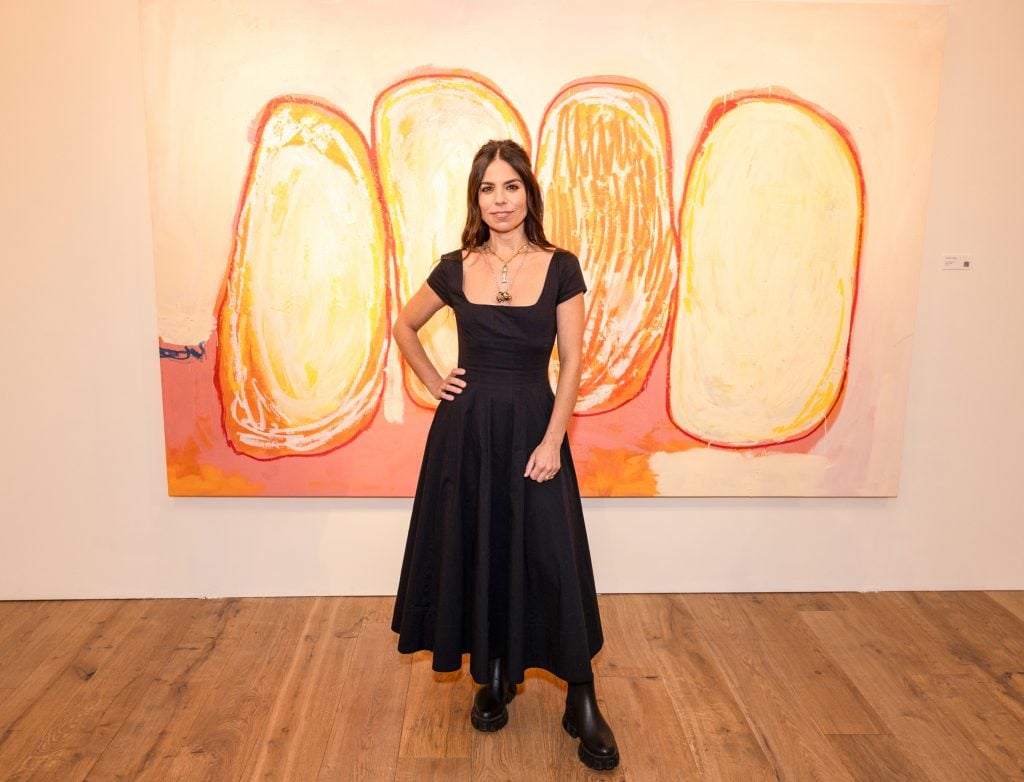
It would be easy for haters to dismiss Alexandria Hilfiger’s seriousness as an artist. Undoubtedly best known as the daughter of famed American fashion mogul Tommy Hilfiger, she’s had a number of high-profile but brief projects in her 39 years, including her starring role in the cult classic MTV reality show, Rich Girls, followed by the 2011 launch of a since-defunct clothing label. Outside of the spotlight, however, Hilfiger has quietly sustained an artistic practice for the last 25 years, channeling a fashion designer’s fine-tuned sensitivities to color, composition and texture into abstract painting. Following her recent exhibition at the Georgian Hotel’s Gallery 33 in Santa Monica I’ve come to vouch: contrary to haters’ expectations, Hilfiger’s paintings are actually good.
She will have work in the group exhibition, “It’s Time to Slow Down,” at New York’s Visionary Projects in June. Hilfiger, who lives in Palm Springs with her daughter and husband, artist Steve Hash, began painting as a teenager during a traumatic period growing up in New York; the death of her uncle had coincided with both the attacks of 9/11 and her parents’ separation. From their painting became both a diaristic and therapeutic activity, particularly during the debilitating stages of her undiagnosed Lyme disease. (As a survivor and advocate, she chronicled her ordeal in her 2017 memoir, Bite Me: How Lyme Disease Stole My Childhood, Made Me Crazy, and Almost Killed Me.)
Earlier this spring, I met Hilfiger at Gallery 33 for a walkthrough of “Imperfect Harmony,” her solo Los Angeles debut. Featuring a dozen or so small- to mid-scale paintings, the show expressed a clearly defined aesthetic: softly organic forms, and a meaty, layered application of acrylic paint that emulates the textural qualities of oil. We discussed Hilfiger’s artistic influences, including Eva Hesse, Lee Krasner, and her mother; the desire to exhibit publicly; and the perks of being an artist who never interacts with the art world.
In this series, you depict nebulous masses that are almost touching. Can you tell me a little bit about where this imagery came from?
These actually came to me on one of my hikes, when I was looking at how different rocks push up against each other. My visual language is symbolic of different emotions, and so they made me think of the pressures of keeping all of our feelings together.
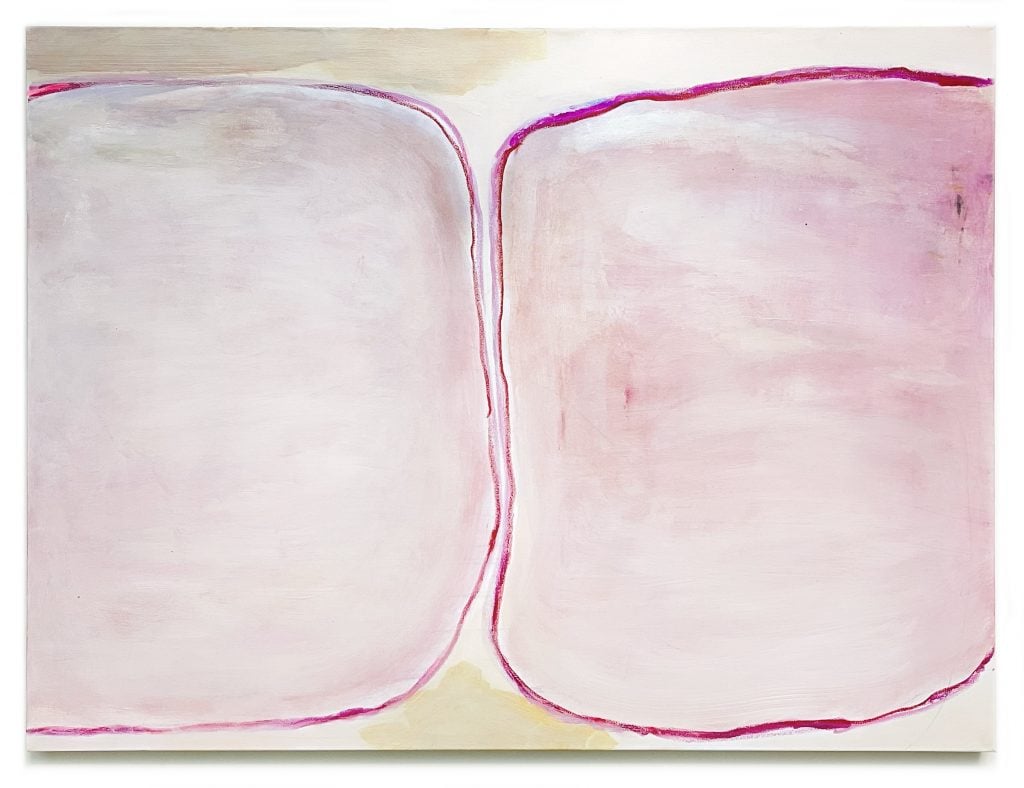
Alexandria Hilfiger, Pressure I (2024). Courtesy of Gallery 33.
I’m surprised that you mention rocks—there’s something so bodily and fleshy about these paintings, almost like organs, especially with the bluish pinks you used.
I think a lot of my work can seem a bit cellular and bodily, and I think that’s because of my years dealing with bloodwork and Lyme disease. During the healing process, I did a lot of work to visualize what was happening to me internally in order to transmute some of that energy. I’m still exploring—I’ll study and read a lot or watch a lot of documentaries. In many of my works I try to incorporate the entire spectrum underneath the final color, building up the vibrations of all the colors underneath so that some of them show through.
The result is so luminous, really. And the acrylics actually look like they’re oil.
Since I was young, I’ve loved figuring out how to manipulate acrylics to achieve the depth and heaviness of oil or even gouache. I’m more familiar with acrylic, so it’s sort of less intimidating to me; it’s quick drying, and you’re able to pile acrylics on top of each other over and over again.
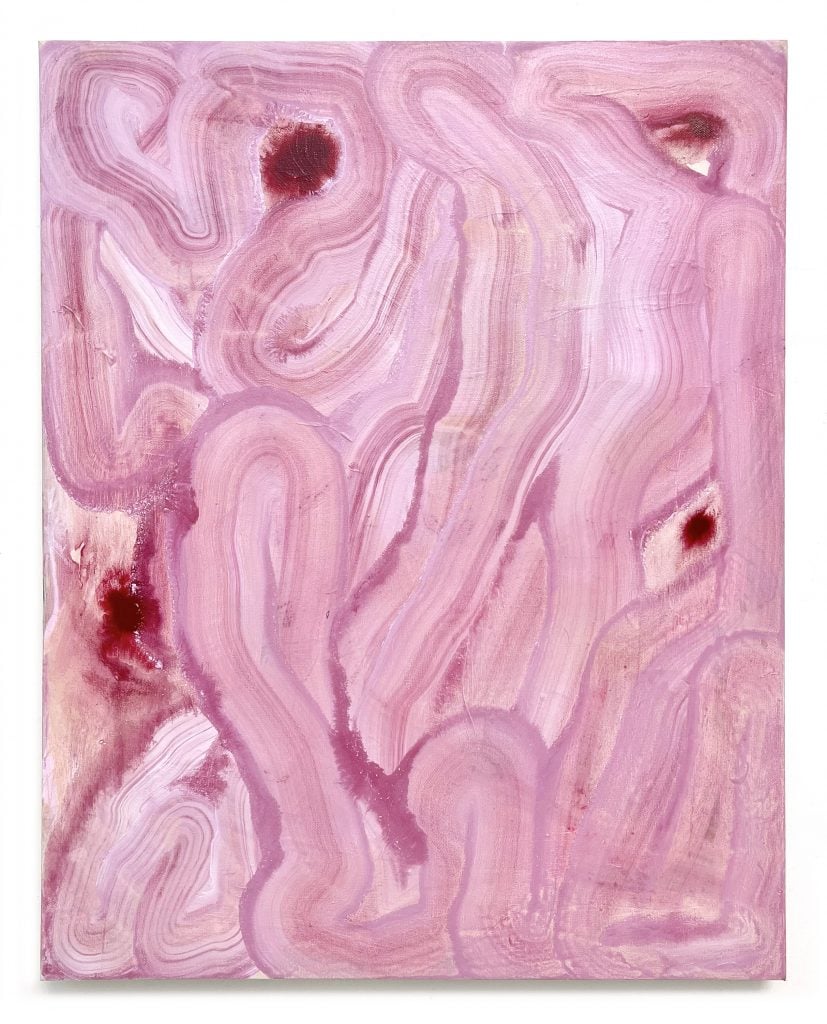
Alexandria Hilfiger, Pathways III (2024). Courtesy of Gallery 33.
What’s funny is that one of the most searing critiques I’ve ever heard was about an artist who made oil look like acrylic.
Oh, now that’s bad!
So bad! But I’d love to hear more about your relationship with art and painting, starting in the most practical sense—you said you started painting when you were 15 years old?
Yes. It was the week of 9/11. We were in New York and watched the towers go down. Two or three days later, my dad’s brother who we were helping to take care of died of brain cancer. My parents were also separating, so there was a lot going on. After all the deaths and all the trauma, I think I might have watched one of Julian Schnabel’s films and gone out to Pearl Paint and just bought some materials that spoke to me. And I just painted. One of my first pieces was a large pack of Marlboro Lights in the middle of neon flower fields with glitter, and I just kept going. I painted every single day after high school.
Your father is obviously a major fashion designer and he’s also a known collector of pop art. What can you tell us about the kinds of art you grew up with, and how fashion might’ve also influenced your painting practice?
My dad collects a lot of Basquiat and Warhol, but I grew up with more traditional art—you know, classical oil paintings of horses, aristocrats, and ship captains. My mom was an amazing, very old-school English interior designer and a true genius colorist, and our homes had such attention to detail and perfection. As my mother and father were doing their homes, or as I would work with my father in his office with the designers, I’d go sample-shopping with them in Europe, which was the most fun thing ever. I got to see all of these different ways that colors and textures could be layered together.
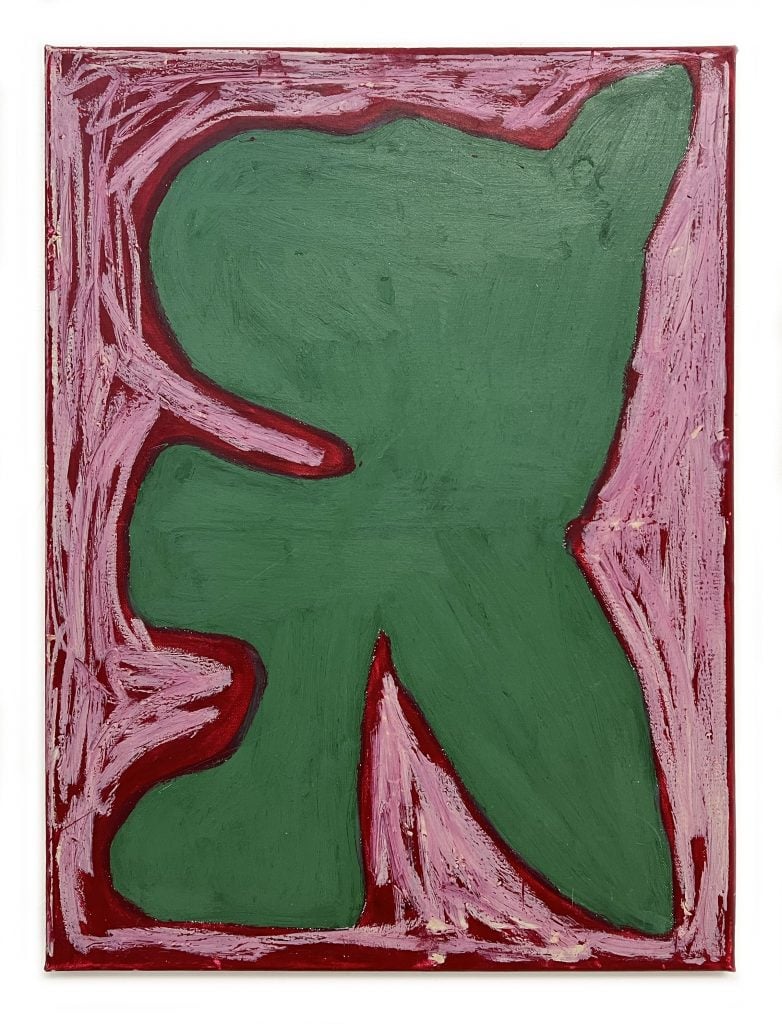
Alexandria Hilfiger, Body Language II Dancing in the Garden (2022). Courtesy of Gallery 33.
Is there something about painting that attracts you in a way that these other creative fields don’t?
I really love designing clothing, and I’m good at it—but painting is so much more tactile and personal, which is why I kept it private for so long. Mainly it’s therapeutic, and I felt that maybe the fashion business is just less personal.
Because it operates in response to a market?
Exactly. You know, I tell my daughter that abstraction is a way to process and transmute your emotions—to use color and form to see what anger looks like, for example—and now that’s what she likes to do with me in the studio. But listen, even for Alexander McQueen or Galliano, the most amazing artists in fashion, it’s hard to make that into a business. But I also don’t want to just make paintings and have them sit in my barn and rot away. I want them to actually help people and heal people if they can.
It sounds to me like your practice is deeply rooted in an emotional place, rather than influenced by any external trends.
I don’t know any, actually. I don’t know what the trends are.
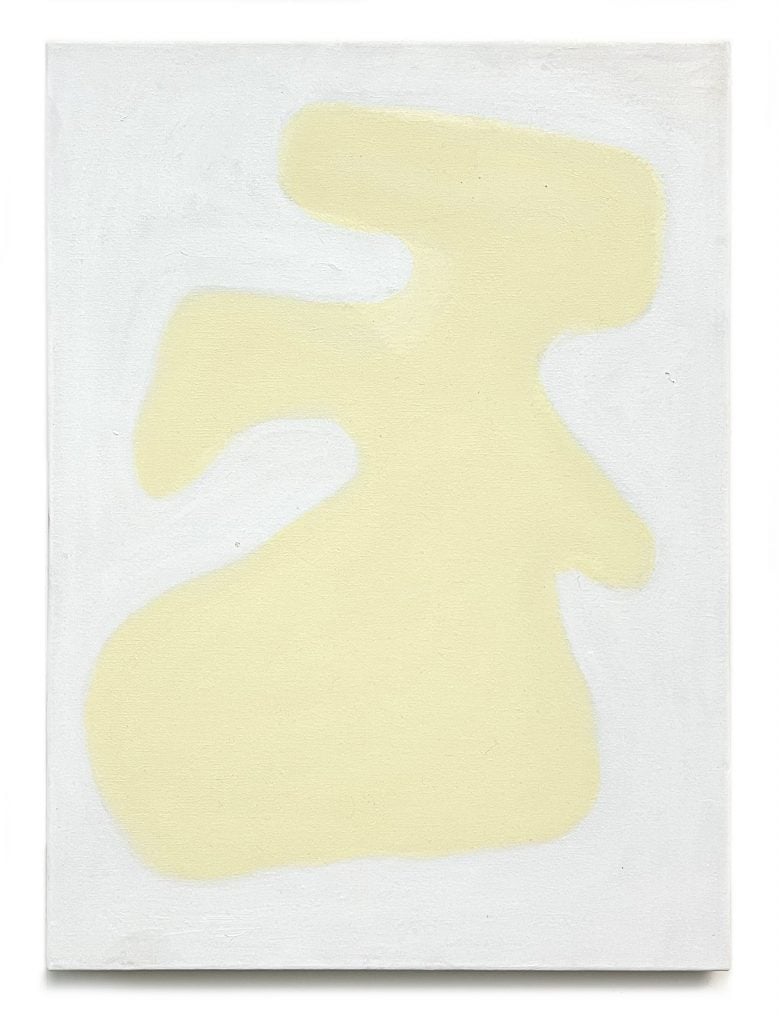
Alexandria Hilfiger, Body Language IV Floating in Space (2024). Courtesy of Gallery 33.
Are there paintings in your life that you felt particularly moved by? Ones where you felt the artist had left a true emotional imprint in their work?
Yes, I really felt that with the first paintings Lee Krasner did after Pollock’s death; I think it’s called The Seasons, and it’s in the Whitney, and it brought me to actual tears. I think Eva Hesse, too, brought me back to myself as an artist. After I had my daughter and published my book about Lyme disease, I had a kind of identity crisis; I hadn’t picked up a pen or a brush in five years because I was a mother and working as an advocate, and I didn’t really understand how deeply crucial it is to an artist’s existence to actually make work. It became a crisis until I found her documentary. Relating to her work is hard to articulate—I just felt connected to her hand and her thought process in a way I could identify with.
This show includes a few bodies of work that date back to the last three or four years. What was happening during this period of time?
There’s moments in the day or in life where things can get extremely overwhelming. COVID was one of those times where everyone, no matter who they were, was in some sort of form of crisis, and when I had really chronic, intense Lyme disease, my brain would feel so scrambled and overwhelmed I would just shut down. I remember at one point, I just picked up some India ink and just started painting lines, one by one next to each other, and it would start to calm my brain. As I made each line, I understood that the undulations or the imperfections of each movement of the line would represent the moments in a day or the different emotions we feel in the day. And then afterwards, when you can look at it from an outside perspective, the last 14 days can look beautiful together.
That’s beautiful—the idea of art as an accumulation.
It is. It’s the memories and decisions of our lives, the thoughts and feelings that we have, and instead of sort of getting stuck in moments of chaos, making the lines was my way to process and breathe. When I looked back with that perspective, I thought, wow, if we could zoom out and look at the whole of our lives—the ups and the downs and the pitfalls—it’s beautiful when you look at it all together.





